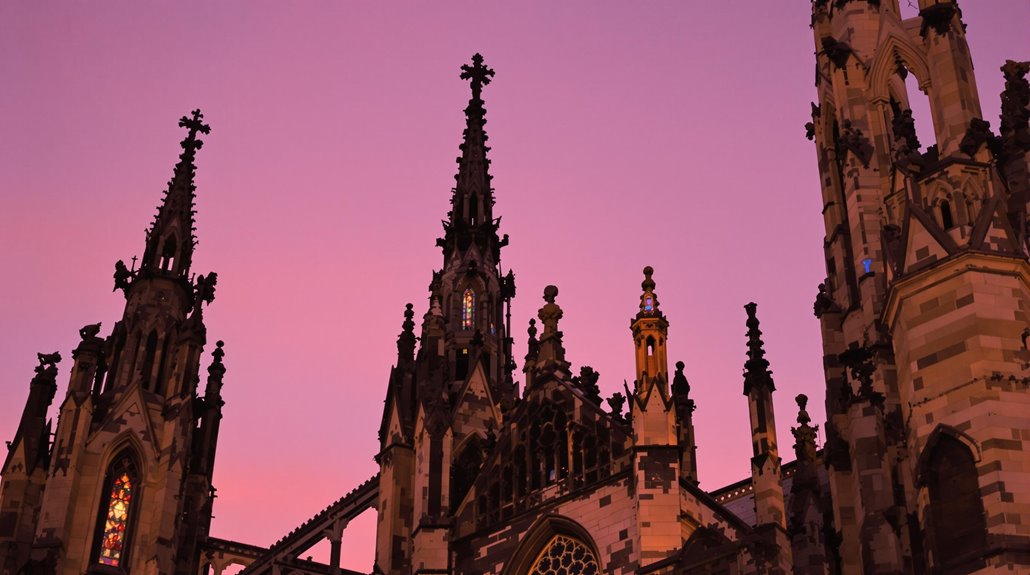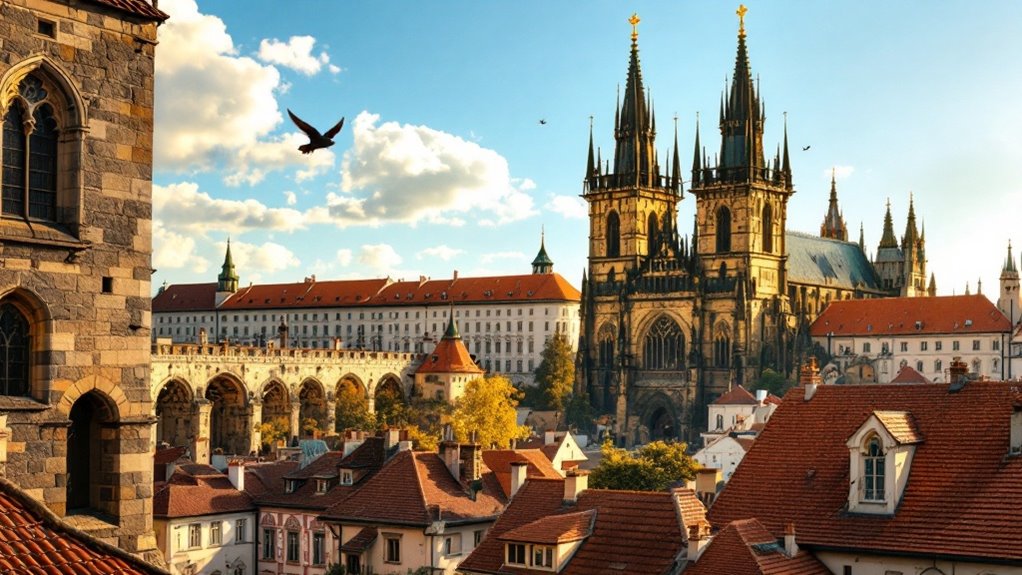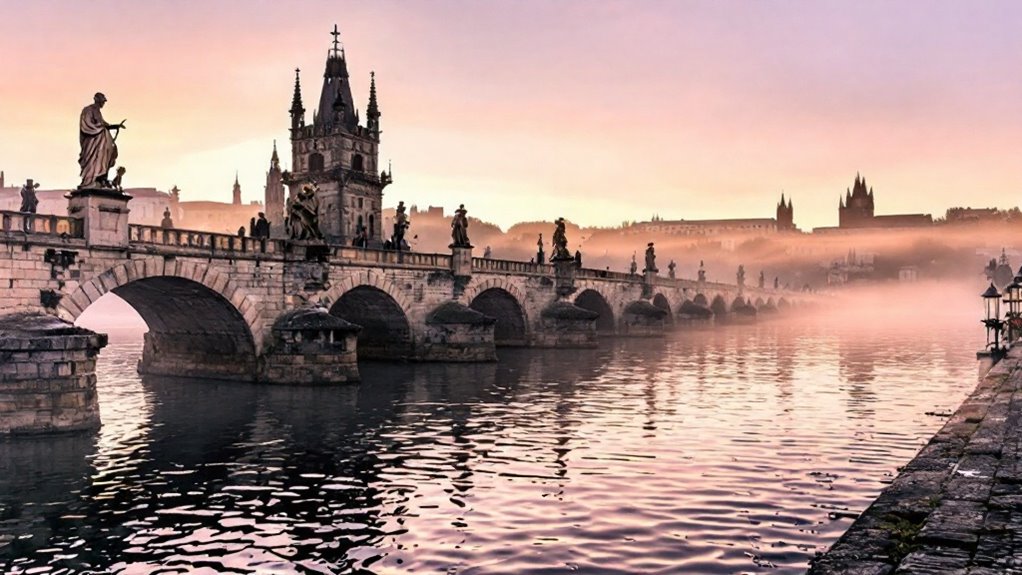Physical Address
304 North Cardinal St.
Dorchester Center, MA 02124
Physical Address
304 North Cardinal St.
Dorchester Center, MA 02124

You'll discover Prague's most stunning buildings aren't just scattered across the city by chance – they tell a thousand-year story of power, faith, and rebirth. From the world's largest ancient castle to a modern building that appears to dance, these five architectural marvels showcase Prague's evolution from medieval times to the present. Each structure holds secrets and surprises that'll make you rethink what you know about European architecture, and there's much more to uncover about their fascinating histories.

Standing majestically above Prague for over a millennium, Prague Castle began as a humble wooden fortress in 870 CE under Prince Bořivoj I before evolving into Europe's largest ancient castle complex.
You'll discover traces of every major architectural period within its 110-acre grounds, from the Romanesque cellars to Gothic vaults and Baroque additions.
As you explore, you'll notice how each ruler left their mark: Charles IV's Gothic transformation added ribbed vaults, while Ferdinand I introduced Renaissance elements after the 1541 fire.
The Vladislav Hall showcases stunning Late Gothic ceilings, and Maria Theresa's Baroque renovations brought gilded grandeur. This magnificent site became even more significant when it served as the seat of Habsburg power in the 16th century.
Don't miss the Renaissance Belvedere Summer Palace or the Spanish Hall's ornate Mannerist frescoes.
Today, this UNESCO World Heritage site continues to blend medieval charm with modern preservation efforts.
A masterpiece of Gothic architecture, St. Vitus Cathedral stands as Prague's most iconic spiritual landmark. You'll discover this magnificent structure within Prague Castle, where it's taken nearly six centuries to complete its construction, from 1344 to 1929.
When you visit, you'll notice the French Gothic design by Matthias of Arras, enhanced by Peter Parler's innovative net-vaulted ceilings and intricate stonework. Don't miss the stunning 7-meter rose window on the western facade or the Art Nouveau stained glass by Alfons Mucha in the northern nave. The cathedral's impressive design incorporates flying buttresses for support.
The cathedral's 96.5-meter South Tower offers breathtaking city views after climbing 287 steps.
Inside, you can explore the golden St. Wenceslas Chapel, housing the saint's tomb, and marvel at the Royal Mausoleum where Czech kings rest.
As part of the UNESCO-listed Prague Castle complex, it's a must-see representation of Czech cultural heritage.

For over six centuries, Prague's Charles Bridge has captivated visitors as one of Europe's finest medieval bridges.
You'll discover this architectural marvel spanning 516 meters across the Vltava River, featuring 16 impressive sandstone arches and three Gothic towers. Built between 1357 and 1402, it served as Prague's only river crossing until 1841.
This magnificent stone bridge, with its trio of Gothic towers and 16 graceful arches, dominated Prague's river crossings for nearly 500 years.
When you visit, you'll notice the bridge's innovative design elements, including angled piers that deflect flood waters and ice guards protecting the arches. The bridge was designed by the renowned Petr Parler, who masterfully incorporated Gothic architectural elements.
While the famous Baroque statues lining the bridge are now replicas, they'll give you a sense of the structure's rich history.
Today, you're witnessing the bridge during its 20-year restoration project, ensuring this medieval masterpiece continues to connect Prague Castle with Old Town for generations to come.
Iconic twin spires pierce Prague's skyline from the Church of Our Lady Before Týn, a Gothic masterpiece that took over 150 years to complete.
You'll notice the asymmetrical design – the north tower's slightly bulkier frame symbolizes masculine strength, while both spires reach an impressive 80 meters high.
Construction challenges were immense. Workers had to build behind existing houses, accessing the site through a narrow Gothic arcade.
After surviving political and religious turmoil, the church faced disaster when a 1679 fire destroyed its original Gothic towers. They were rebuilt in Baroque style, though you can still admire the pointed pinnacles and intricate stone tracery.
The church's history reflects Prague's religious shifts – it served as the main Hussite church until 1621, when Catholics reconsecrated it, replacing its golden chalice symbol.
Inside, visitors can marvel at the oldest pipe organ in Prague, an exquisite instrument crafted in 1673 by Heinrich Mundt.
While Gothic spires define Prague's medieval heart, the city's modern spirit dances along the Vltava River in the form of the Dancing House.
You'll see two distinct towers – one concrete, one glass – twirling together like Fred Astaire and Ginger Rogers, the building's famous namesakes.
Completed in 1996, this deconstructivist masterpiece by architects Frank Gehry and Vlado Milunić stands on a site destroyed during WWII.
Though initially controversial for its stark contrast to Prague's historic architecture, it's now celebrated as a symbol of the country's post-communist transformation.
The building's innovative design features 99 concrete panels, each uniquely shaped to create its distinctive undulating appearance.
You can experience the Dancing House beyond its striking exterior.
Head to the top floor's Ginger & Fred Restaurant for panoramic city views, or enjoy sunset drinks at the Glass Bar overlooking Prague Castle.
You will discover that Prague architects didn't directly influence the Vienna Secession movement. Instead, Viennese architects like Otto Wagner influenced Prague's designers, leading to Czech Cubism and unique architectural interpretations in Prague's cityscape.
You'll be shocked: Communist rule devastated Prague's historic sites through systematic neglect. They'd prioritize prefab housing over preserving castles, often demolishing deteriorating monuments rather than restoring them. Traditional preservation skills were lost entirely.
You will discover Jewish architects were key pioneers of Prague's modernist movement, introducing Art Deco and Functionalism in the 1930s. They created innovative social housing and brought geometric simplicity to residential buildings across the city.
Like geometric gems scattered across the city, you will discover stunning Cubist works at the House of the Black Madonna, near Wenceslas Square's unique lamp post, and at Kovarovic Villa in Vyšehrad. They're all free to view.
You will discover Prague's architecture largely intact because the city faced only four Allied raids during WWII. The limited bombing in 1945 damaged just a few landmarks, while Nazi occupiers actually preserved the city for propaganda purposes.
You've walked through Prague's greatest hits, and your wallet's probably crying by now (those tourist tickets aren't cheap). But let's be real – where else can you see a castle that's seen more makeovers than a fashion influencer, a bridge that's outlasted most marriages, and a building that looks like it's had one too many Czech beers? That's Prague for you – historically priceless, but worth every crown.